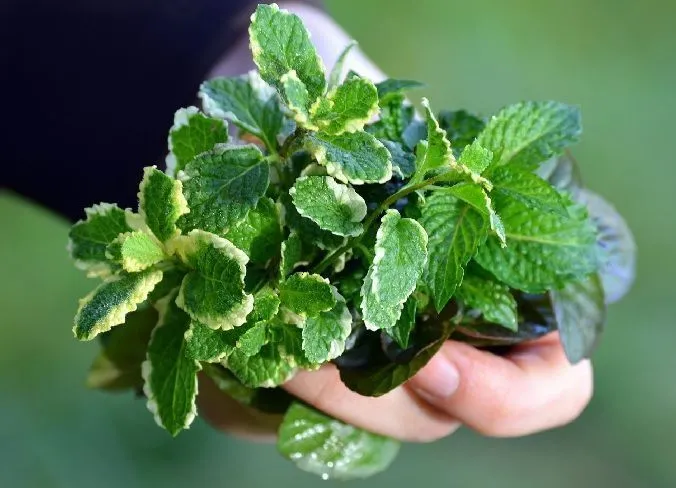The properties of mint they are more than demonstrated, since it has been and is a widely used crop and focused on hygiene products, such as mouthwashes, toothpastes or even some gels or shampoos. In the kitchen, something less known, the incorporation of mint in desserts is increasingly gaining strength, as it combines very well with chocolate.
Therefore, we will unravel all the properties of mint from knowing its phytochemical composition and the potential of each of its components.
Table of Contents
Before knowing the properties of mint, we see how it is grown
Starting from scratch
The first thing is to build the base of the pot or growing table. In this case, when choosing the best substrate, it is convenient to select the homogeneous mixture of soil with compost or organic matter.
At the bottom of the container is usually incorporated a base of gravel or edges that will filter the water and help improve the drainage of the container. As always, stagnant water is not good for any crop of aromatic plants or medicinal plants, as it will produce rot.
How to water mint grown in pots
The demand for peppermint irrigation is quite high. That is, we will have to look for a constantly wet substrate (but not waterlogged, we return to what was before!).
Mint grown in pots usually has a watering every 2 or 3 days in periods of maximum heat. Once a week, as a general rule, if it is colder.
To learn more about mint, we recommend this article on how to grow mint indoors.Soil characteristics
Mint, as a crop, adapts to a wide variety of soils and situations. It is very common to see it grown in pots, and that does not affect its medicinal properties.
It has been documented that both the characteristics we give in irrigation and the nature of the soil influences the properties of mint. This is because the plant will be able to produce more or less of the phytochemicals that will be mentioned later.
Chemical composition of mint
The medicinal and even aromatic properties are defined by the sum of the components. In the case of mint, it is loaded with essential oils and active ingredients that can produce great benefits. You’ll see them below.
- Essential oil content: 1-3%, especially menthol.
- Caffeic acid
- Rhomparic acid
- L-carvone as responsible for the characteristic smell of mint.
- Limonene. A compound present in citrus fruits and in the celery.
- Caryophyllene
- Dihirocarvol

Properties of mint (medicinal)
In mint, along with all the applications it has in cosmetics and food, we can find a lot of beneficial properties for health.
We can find some of the following properties of mint.
- Improves digestion in heavy meals.
- Help decongest the airways when we have colds.
- Improves blood circulation.
- It is used to combat halitosis and the bad taste in the mouth, reducing the condition of cavities and oral problems.
- Antioxidant action and vitamin intake.
What if we talk about peppermint oil?
It is easy to make a concoction based on peppermint oil, for applications to our skin. With this we get some beneficial effects, applied by means of a compress or poultice. In short, the properties of topical mint also exist. Scope:
- Reduce muscle inflammation and pain (back, arms, legs, etc.).
- Treatment of wounds, scars and insect bites.
- Headache relief with cloths soaked in peppermint oil.
Also, what we talked about earlier about the content in menthol as an essential oil, it is one of the compounds that is practically always present in dental products.
And to say that, it is not only because of its aroma, since menthol has antiseptic properties. In fact, many years ago (and there will be those who still do it at certain times), I chewed mint leaves. With this we improve our breath and reduce the concentration of germs in teeth, tongue and gums.
Shall we have a mint tea?
Of course, a very nice drink would be a mint tea. In fact, current pennyroyals improve their flavor by incorporating mint, known as pennyroyal-mint.
This preparation relieves stomach problems and improves digestion. In addition, the elaboration process is really simple:
- 2-3 dried mint leaves per cup of water.
- Boiling water.
- Strain and take.
Side effects. Not everything was going to be good
Although the side effects are quite low and the properties of mint far exceed these drawbacks, it must always be considered that medicinal plants also have their dosage and contraindications.
The use of mint has been studied a lot, proving that there are cases where it is better to reduce the intake of the contents that mint provides. For such a case, it is recommended to reduce the taking of peppermint in people with hiatal hernias, biliary obstructions, gallstones, etc.
With regard to pregnant women, you should always consult with an expert. Some active subjects affect (positively or negatively) this vital stage of the child’s development.
Do you know other properties of mint? Your opinion interests us! Tell us and provide interesting information.
You may be interested in our article about Design your medicinal plant garden

1 thought on “Properties of mint as a medicinal plant”